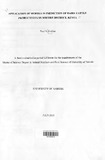| dc.description.abstract | Two models, Integrated Modeling Platform for mixed Agriculture Crop sysTem (IMP ACT)
and Livestock Feeding Strategies Simulation Models (LIFE-SIM), used to assess farm
characterization and prediction of milk yield were validated using data collected in
smallholder dairy farms in Mbeere District, Kenya. Data were collected in arid and semi-arid
environments under two smallholder dairy production systems in Evurore and Siakago
Divisions. Data were collected using a structured questionnaire in a cross-sectional study
from randomly selected 17 farms in each Division during the months of March and April,
2007. The data captured included: climate, land management, livestock management, labor
allocation, farm's sales and expenses, and soil nutrient flow. A detailed longitudinal study
followed in a random sample of six farms from each Division for three months between May
and July 2007. The detailed study covered farms with lactating dairy cows, where data on
breed, parity, lactation length, milk yield, feed types and their intake, calving intervals and
biweekly weight changes were collected.
The mean household size was 5.3 and 5.1 persons (median 5 and range 2-8) for Evurore and
Siakago, respectively. The common dairy cattle breeds were Ayrshire and Friesian. The mean
milk yield was 8.1 and 7.0 kg/cow/day for Siakago and Evurore, respectively with a range of
2.5-10.2 kg/cow/day. For the stall managed dairy animals, most farmers used crop residues
and cut pastures as the main source of feed. The feeds were sourced from both within and
outside the farms, and ranged from planted and natural forages, crop residues to commercial
and home-made concentrates. In both Divisions, the basal feed resource was maize stover.
However, methods of processing the stover prior to feeding varied, either fed whole in
unprocessed form to chopping using either machete (panga) or chaff-cutter. Rhodes grass was
the main ley pasture and was used by 17% Of the farmers, while natural pastures mainly
consisted of Cynodon spp and Rhychelyntrum species. During the dry period, when various
VI
feed resources were in short supply, banana stems and cereal by-products (wheat and rice
bran and pollard) were used to sustain the animals. Data from 33 mixed crop livestock farms
in the cross-sectional study were used to validate IMPACT model. A snapshot baseline
analysis of farm cash flow with IMPACT identified three main sources of income; crops,
dairy and off-farm. Crop and/or dairy farming constituted the major source of income. Crops
contributed 39% and 32% for Evurore and Siakago respectively while livestock contributed
35% and 58% in Evurore and Siakago respectively. Annual income from crops was estimated
at KES 1.8± 0.21 and 1.7± 0.29 million for all the farms in Siakago and Evurore respectively
whereas annual income from dairy farming was estimated at KES 3.3 ± 0.31 and 1.5± 0.08
million for Siakago and Evurore respectively. Off farm income was contributing 25% of
income in Evurore but was insignificant source of income for farms in Siakago Division.
The LIFE-SIM model predicted a mean lactation yield of 2351 ± 380kg equivalent to 7
kg/cow/day (305 days) which was below mean potential yield of 2649 ± 222kg. 70% of the
cows had a deviation of less than 5% of the real recorded yield compared with the predicted,
while 30% had a deviation of between 5- 10%. The model was therefore able to predict milk
yield to a reasonable degree. | en |

